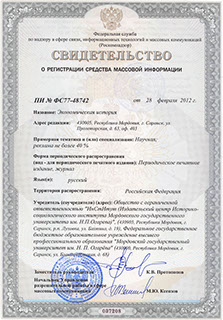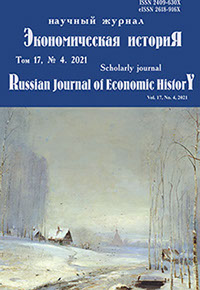Экономическая историЯ
Russian Journal of Economic History
ISSN 2409-630X (Print)
ISSN 2618-916X (Online)
Expert board:
- Scientific Council of RAS on economic history;
- Research and Educational Center «The economic history of Central Russia and the Middle Volga region» of Ogarev Mordovia State University;
- Center of Economic History of Lomonosov Moscow State University
Navigation
Certificate of registration

ISSN 2409-630X (Print), ISSN 2618-916X (Online)
DOI: 10.15507/2409-630X.055.017.202104.361-369
УДК 94:336.02(470.40/.43)
Tatyana A. Pershina1, Tatyana V. Shitova2
1 National Research Ogarev Mordovia State University (Saransk, Russia), е-mail: 730791@bk.ru
2 Nizhny Novgorod Academy of the Ministry of Internal Affairs of Russia (Nizhny Novgorod, Russia), e-mail: shitova.tv@mail.ru
Expenditures of Rural Societies and Volost Boards in the 1880s – 1890s (Based on the Materials of the Middle Volga Region)
Introduction. The comparative analysis of the expenditure part of rural and township budgets of the Middle Volga provinces in the 1880s – 1890s is presented. Materials and Methods. The study is based on the comparative method. Quantitative, problem-chronological, system analysis and structural methods were of auxiliary importance. Results. The comparison of data on the Middle Volga provinces shows that in the 1880s – early 1890s, the mundane expenses of rural societies were twice as high as the costs of the volost boards. A significant part of the worldly fees went to pay employees of volost boards; much more modest funds were allocated to representatives of peasant self-government bodies, and, in their totality, these funds were steadily declining at the end of the XIX century. Discussion. In many areas of the Middle Volga region in the 1890s, rural electors did not receive any payment at all. The item of expenditure of local self-government bodies designated as “other expenses for the management and conduct of all kinds of public affairs”, which included the costs of renting apartments for officials, paying for the travel of officials and elected officials, delivering taxes to the treasury, the costs of conducting court cases, hiring servants and accounting officials was quite noticeable for rural societies at the very beginning of the 1890s, but gradually decreased. The amounts spent under this article by rural societies significantly exceeded the volost ones. During the period under review, the protection of public safety and fire-fighting measures were financed mainly from the fees of rural societies. An important component of the “mundane budgets” were the so-called “agricultural expenditures”, which included a wide range of operations aimed at organizing agriculture and animal husbandry. Conclusion. The reform of taxation and the system of local self-government in Russia in the 60–70s of the XIX century provided rural societies with wider opportunities for spending funds to meet urgent needs. A certain independence in the approval of expenditure items can be traced in the specifics of the costs of individual volosts and rural societies of the Middle Volga provinces. Allocating a significant part of worldly fees for payments to employees of volost boards, the peasantry preferred to minimize their own expenses on self-government bodies. The costs of “managing and conducting all kinds of public affairs” were quite palpable for the villagers at the very beginning of the 1890s, but also gradually decreased.
Keywords: mundane expenses, rural society, volost government, modernization, the Middle Volga region.
For citation: Pershina Т. А., Shitova Т. V. Expenditures of Rural Societies and Volost Boards in the 1880s – 1890s (Based on the Materials of the Middle Volga Region). Ekonomicheskaya istoriya = Russian Journal of Economic History. 2021; 17(4): 361–369. (In Russ.). DOI: 10.15507/2409-630X.055.017.202104.361-369.
© Ogarev Mordovia State University. History and Sociology Institute, 2017
68, Of. 411, Bolshevistskaya St., 430005, The editorial office of the scholarly journal «Russian Journal of Economic History»
Tel.: (8342) 24-25-90; 27-07-11, Fax: (8342) 24-25-90, E-mail: jurnal-econom-hist@isi.mrsu.ru
Designed by A. Napalkov, Email: napalkov@isi.mrsu.ru

